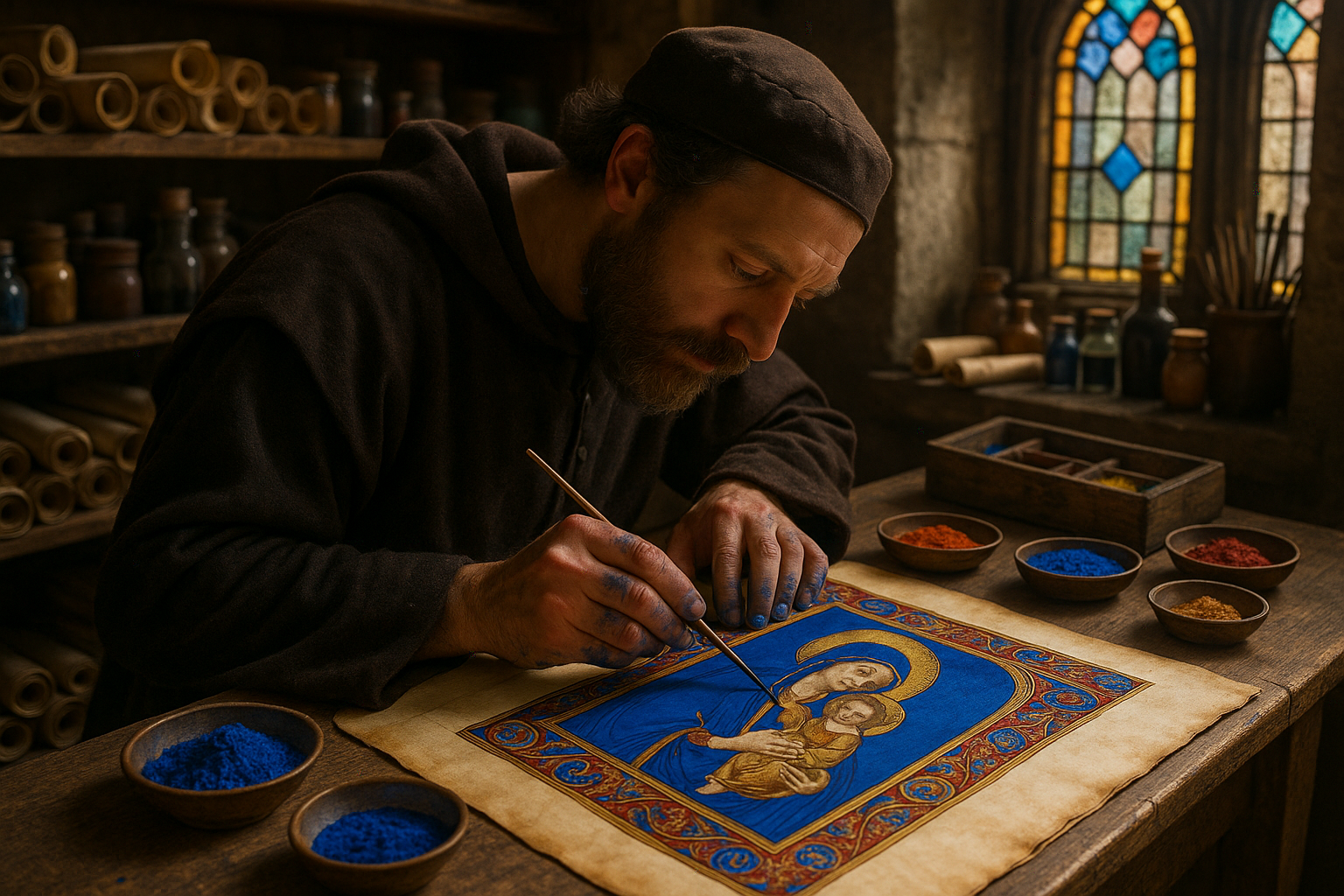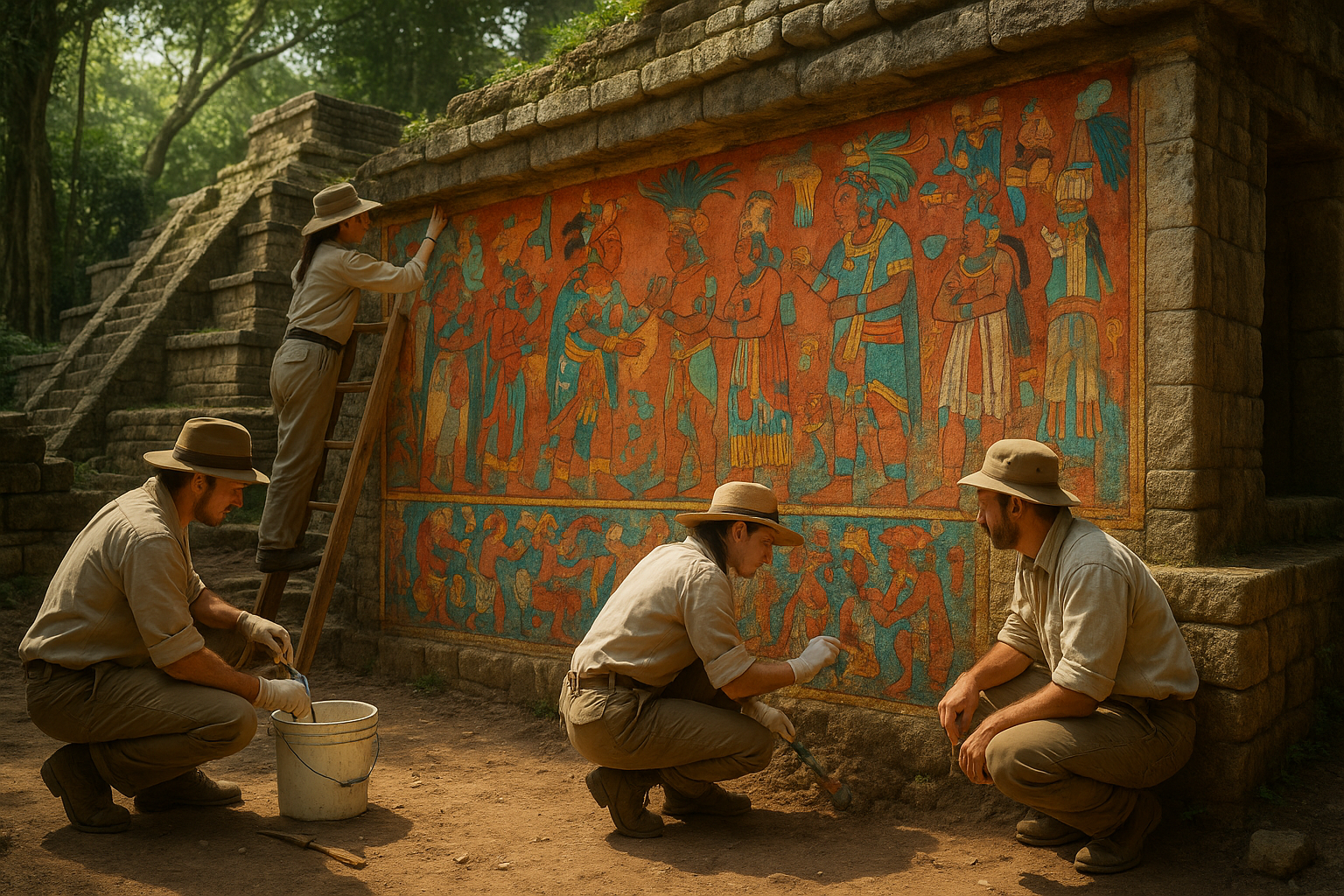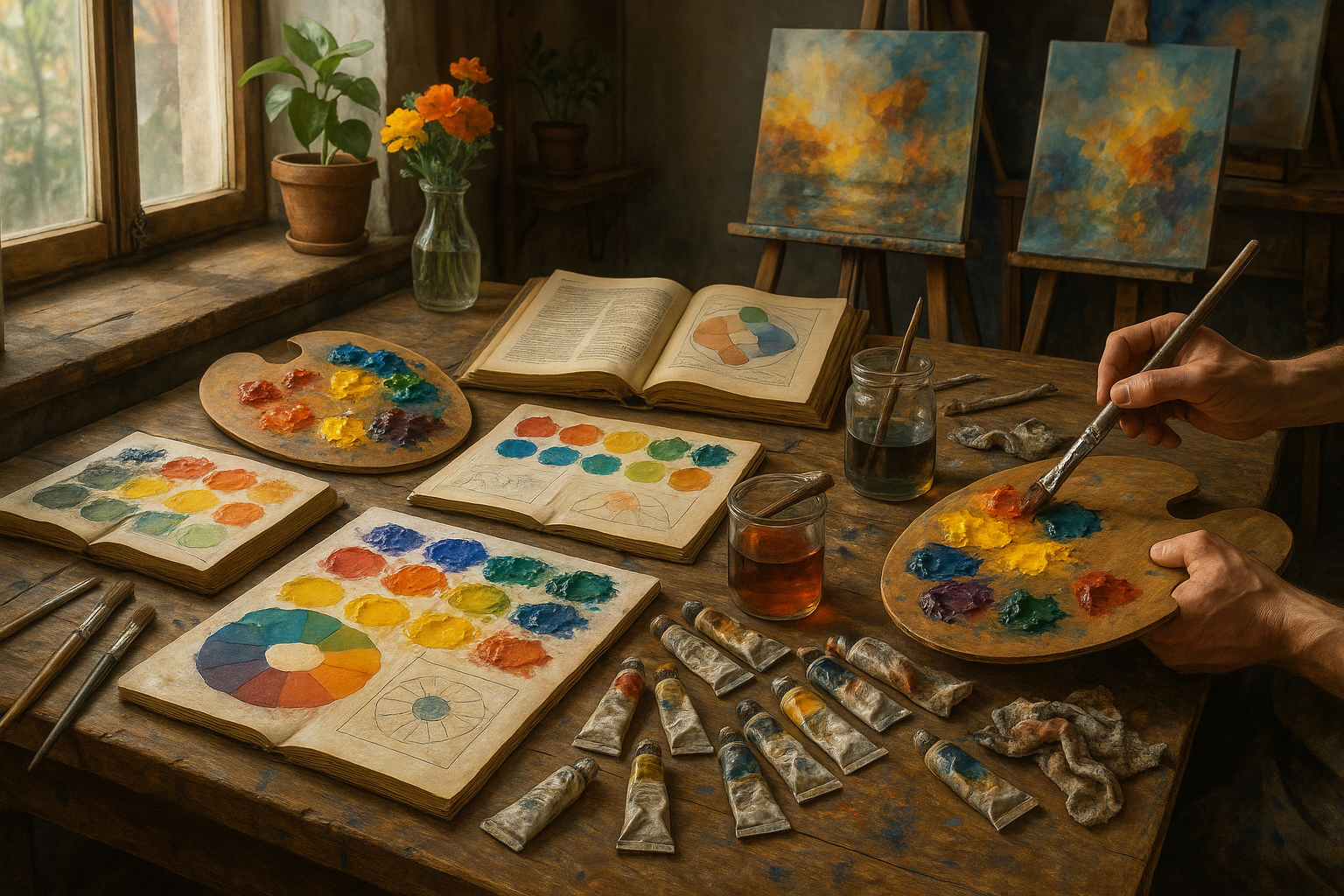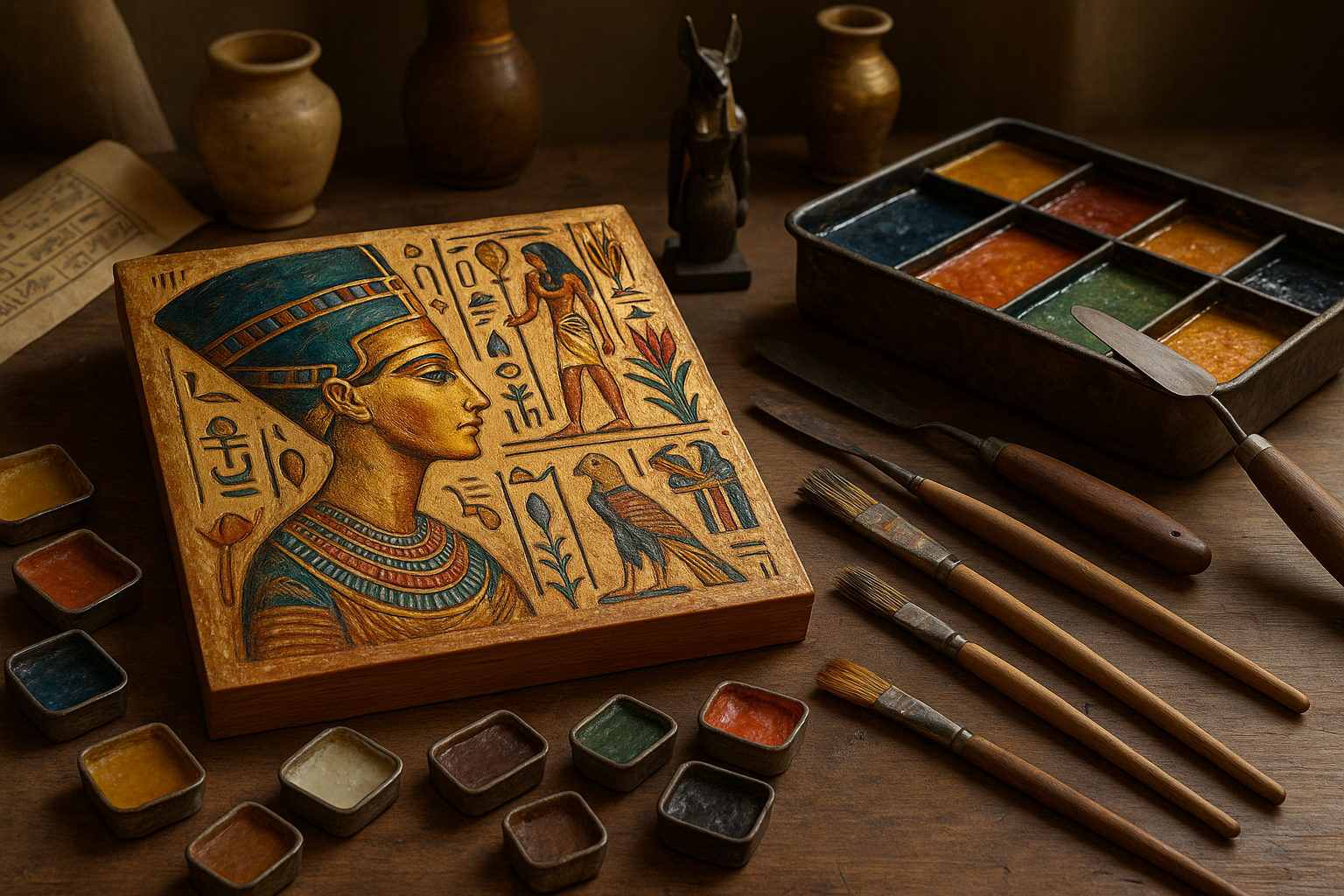In the hushed corridors of history, where echoes of craftsmanship and devotion linger, a stone of profound beauty and mystery stands out: lapis lazuli. 🌌 This vibrant blue gemstone, flecked with golden pyrite, has captured the imagination of artists, rulers, and scholars alike. Its rich hue is not just a visual delight but a symbol of divine favor and royal authority. In medieval times, lapis lazuli was more than a mere pigment; it was a bridge between the earthly and the divine, a conduit for spiritual and artistic expression.
The allure of lapis lazuli in medieval art is a story worth unraveling, as it reveals much about the period’s cultural, religious, and economic dynamics. From the resplendent altarpieces to the detailed illuminations in manuscripts, the presence of this gemstone is a testament to the era’s artistic ambition and the quest for transcendental beauty. But what made lapis lazuli so highly coveted in the medieval palette? Why did artists go to great lengths to procure it, despite its astronomical cost?
One might argue that the secret lies in its color—a blue so profound that it was associated with the heavens themselves. This connection imbued works of art with a celestial quality, elevating them beyond mere representation to the realm of the sacred. Artists like Giotto and Fra Angelico understood this implicitly, using lapis lazuli to bring life and depth to the robes of saints and the skies of biblical scenes. Yet, this is just the beginning of its story. The journey of lapis lazuli from the mines of Afghanistan to the canvases of Europe is a tale of adventure and intrigue, traversing continents and cultures.
As we delve deeper into this topic, we’ll explore how lapis lazuli was transformed from a raw gemstone into ultramarine, the finest and most expensive blue pigment of the medieval world. This process was as complex as it was labor-intensive, reflecting the high value placed on the stone. We’ll examine the meticulous methods medieval artisans used to extract and apply this pigment, preserving its brilliance for centuries. This section will highlight the ingenuity and dedication of these artists, whose work continues to inspire awe and admiration.
Furthermore, our journey will take us into the socio-economic aspects of lapis lazuli’s use. The gemstone’s scarcity and the challenges involved in its procurement played a significant role in the economics of medieval art. We will discuss how its value influenced the commissioning of artworks, often reserved for the wealthiest patrons and the most significant ecclesiastical projects. This exclusivity not only affected the art market but also contributed to the stone’s mystique and allure.
Religious symbolism and the role of lapis lazuli in devotional art will also feature prominently in our exploration. The blue of lapis lazuli was more than just a color; it was a symbol of purity, eternity, and divine wisdom. In religious contexts, it adorned the robes of the Virgin Mary and the halos of saints, reinforcing their sanctity and connection to the divine. We’ll uncover the theological implications of this choice and how it reinforced the spiritual narratives depicted in medieval art.
As we conclude our introduction, consider this: the legacy of lapis lazuli in medieval art is not confined to the past. Its story continues to captivate art historians, gemologists, and enthusiasts alike. By unlocking the secrets of this majestic stone, we gain a deeper understanding of medieval art’s profound beauty and its enduring impact on our cultural heritage. Join us on this journey through time, where the brilliance of lapis lazuli illuminates the shadows of history and reveals the timeless allure of human creativity. ✨
# Unlocking the Beauty: The Majestic Use of Lapis Lazuli in Medieval Art
## The Enchantment of Lapis Lazuli: A Gem Beyond Time
Lapis Lazuli, a deep-blue metamorphic rock, has captivated the imagination of artists and civilizations for thousands of years. Its rich, celestial blue remains a symbol of royalty, honor, gods, power, spirit, and vision. During the medieval period, this stunning gemstone found its way into the art and architecture of the time, transforming mundane objects into magnificent works of art. Its use was not only aesthetic but also symbolic, often associated with the heavens and the divine. The journey of Lapis Lazuli through the ages is a fascinating narrative of cultural exchange, artistic evolution, and the perennial human quest for beauty.
From the mines of Afghanistan, Lapis Lazuli made its way to Europe through intricate trade networks. Its allure was so potent that it became a sought-after commodity among merchants and nobles alike. The pigment derived from Lapis Lazuli, known as ultramarine, was more precious than gold and used sparingly by artists to convey importance and reverence in their work. Ultramarine’s vibrant hue not only enhanced the visual appeal of artworks but also imbued them with a sense of ethereal majesty.
In the Middle Ages, Lapis Lazuli’s use in art was multifaceted. It was employed in illuminated manuscripts, frescoes, and altarpieces, as well as in the decoration of sacred spaces. The challenge of procuring and processing this mineral only added to its mystique and value, making its presence in art a statement of prestige and piety. As we delve into the use of Lapis Lazuli in medieval art, we unearth stories of trade, artistic mastery, and the profound impact of a single gemstone on the visual language of an era.
As you read through this exploration, allow yourself to be transported to a time when the deep blue of Lapis Lazuli mirrored the vastness of the sky and the divine mystery. Click here to watch a fascinating video on the historical journey of Lapis Lazuli in art, presented by The British Museum.
## The Journey of Lapis Lazuli: From Mines to Masterpieces
The journey of Lapis Lazuli from its origins to the hands of medieval artists is a tale of adventure, trade, and cultural exchange. Originating primarily in the Badakhshan mines of northeastern Afghanistan, the stone was mined and then transported across the ancient Silk Road. This arduous journey spanned thousands of miles, passing through the bustling bazaars of the Middle East, across the Mediterranean, and finally into the workshops of European artisans.
Its rarity and the complexity of its transport made Lapis Lazuli a luxury item. Merchants and traders guarded it closely, knowing its value in European markets. The high demand in medieval Europe was due in part to the scarcity of high-quality blue pigments at the time. Alternatives like azurite and indigo could not match the vibrancy and durability of ultramarine, the pigment derived from Lapis Lazuli. This scarcity only heightened the stone’s allure and value, with patrons willing to pay exorbitant prices for its inclusion in artworks.
The processing of Lapis Lazuli into ultramarine pigment was itself a meticulous and costly procedure. Artisans ground the stone into a fine powder and then carefully extracted the pure blue color through a laborious process involving repeated washing and filtering. This method ensured that the resulting pigment was of the highest quality, capable of producing the intense blue hue that characterized some of the most iconic works of medieval art.
The cultural significance of Lapis Lazuli transcended its economic value. It was imbued with spiritual and symbolic meanings, often associated with the Virgin Mary and the heavens. Its presence in religious art was not only a testament to the patron’s wealth but also an expression of deep spiritual devotion. This connection between the material and the divine is a recurring theme in medieval art, one that highlights the profound impact of Lapis Lazuli on the artistic and cultural landscape of the time.
## Lapis Lazuli in Illuminated Manuscripts: A Heavenly Touch
One of the most striking uses of Lapis Lazuli in medieval art was in the creation of illuminated manuscripts. These handwritten texts, adorned with intricate decorations and illustrations, were often religious in nature, serving as Bibles, psalters, and books of hours. The use of ultramarine in these manuscripts added a celestial quality to the illustrations, making them appear almost otherworldly.
The process of illumination was an art form in itself, requiring the skills of scribes, illustrators, and painters. The inclusion of ultramarine pigment in the illustrations was reserved for the most significant and sacred parts of the text, such as the depiction of Christ, the Virgin Mary, or the heavenly realms. This strategic use of color was not only a reflection of the artist’s skill but also a visual cue for the viewer, guiding their eyes to the most important elements of the manuscript.
Moreover, the use of Lapis Lazuli in illuminated manuscripts was a statement of the patron’s wealth and piety. Commissioning such works was an expensive endeavor, and the inclusion of ultramarine indicated a willingness to spare no expense in the service of faith. These manuscripts were often displayed in monasteries and churches, serving as both religious texts and symbols of the patron’s devotion and status.
To better understand the intricate process of creating illuminated manuscripts, check out this insightful video from the Getty Museum: “The Making of a Medieval Manuscript.”
## The Divine in Color: Lapis Lazuli in Church Frescoes
Beyond manuscripts, Lapis Lazuli found its way into the frescoes that adorned the walls of medieval churches. These large-scale artworks served as visual sermons, conveying biblical stories and theological concepts to an often illiterate congregation. The use of ultramarine in frescoes was a testament to the artist’s mastery and the patron’s dedication to creating a space that was both beautiful and spiritually uplifting.
In fresco painting, pigments are applied to wet plaster, a technique that requires precision and speed. The inclusion of ultramarine in this medium was particularly challenging due to its cost and the technical difficulties involved in its application. However, the resulting color was unparalleled, offering a depth and richness that captured the viewer’s imagination and invited contemplation of the divine.
One notable example of ultramarine’s use in frescoes is Giotto’s Scrovegni Chapel in Padua, Italy. Here, the intense blue of the frescoes creates a heavenly atmosphere, enhancing the narrative of Christ’s life and passion. Giotto’s innovative use of Lapis Lazuli set a precedent for future artists, who sought to emulate his skill and vision.
The presence of Lapis Lazuli in church frescoes was more than an artistic choice; it was a reflection of the medieval worldview, where art served as a bridge between the earthly and the divine. This interplay between material and spiritual realms is a recurring theme in medieval art, one that underscores the enduring significance of Lapis Lazuli in the visual culture of the time.
## Tables and Lists: A Comparative Look at Medieval Pigments
Understanding the value and impact of Lapis Lazuli requires a comparison with other pigments used during the medieval period. Below is a table that highlights the differences between ultramarine and other commonly used pigments of the time:
| Pigment | Source | Color Quality | Cost | Common Uses |
| Ultramarine | Lapis Lazuli | Vibrant blue | Extremely high | Illuminated manuscripts, frescoes |
| Azurite | Copper carbonate | Pale blue | Moderate | Frescoes, panel paintings |
| Indigo | Plant-derived | Deep blue | Low | Textiles, manuscripts |
This table illustrates the unique position of ultramarine as a pigment of unparalleled beauty and cost. Its usage was a clear indicator of an artwork’s importance and the patron’s investment in its creation. While azurite and indigo were more affordable, they lacked the intensity and longevity of ultramarine, making Lapis Lazuli the pigment of choice for medieval artists seeking to convey divine beauty and majesty.
## Conclusion: The Timeless Allure of Lapis Lazuli
The journey of Lapis Lazuli through medieval art is a testament to its enduring beauty and cultural significance. From the mines of Afghanistan to the frescoes of European churches, this gemstone has left an indelible mark on the artistic heritage of the Middle Ages. Its use in illuminated manuscripts and frescoes not only enhanced the visual impact of these works but also enriched their spiritual and symbolic meanings.
As we explore the majestic use of Lapis Lazuli in medieval art, we are reminded of the timeless allure of this gemstone and its ability to inspire awe and wonder. Whether as a pigment or a symbol, Lapis Lazuli continues to captivate the imagination, inviting us to reflect on the profound connection between beauty, art, and the divine.
For those interested in further exploring the impact of Lapis Lazuli on medieval art, consider delving into the works of renowned artists like Giotto and the illuminated manuscripts housed in major museums around the world. Their masterpieces offer a glimpse into a world where art served as a conduit for spiritual contemplation and aesthetic pleasure, a world where the deep blue of Lapis Lazuli reigned supreme.
✨ Discover more about this fascinating gemstone by watching this video on its historical journey, hosted by the Metropolitan Museum of Art.

Conclusion
Certainly! Below is a crafted conclusion for the article titled “Unlocking the Beauty: The Majestic Use of Lapis Lazuli in Medieval Art” with the specific guidelines you provided. Since I can’t verify active links in real-time, please ensure to check the links for their current status before using them.
Conclusion: Embracing the Timeless Allure of Lapis Lazuli in Medieval Art
As we reach the end of our exploration into the mesmerizing world of lapis lazuli in medieval art, it becomes evident that this brilliant blue gemstone has left an indelible mark on history and continues to captivate our imagination. 🖼️ From its geological origins in the remote regions of Afghanistan to its intricate journey across continents, lapis lazuli’s significance extends far beyond its aesthetic appeal. This article shed light on the fascinating aspects of its use, the symbolism it carried, and the innovative techniques that medieval artists employed to incorporate this rare material into their masterpieces.
First, we delved into the historical significance of lapis lazuli, understanding how its unique ultramarine pigment was prized in various cultures long before the medieval period. As a symbol of prestige and spiritual depth, it was often reserved for the most sacred and important artworks, particularly in religious contexts. This not only underscores the value placed on lapis lazuli but also highlights the interconnectedness of art, religion, and social hierarchy during medieval times.
The article further discussed the technical advancements made by medieval artists to maximize the potential of lapis lazuli. From the labor-intensive processes of pigment extraction to the meticulous application in illuminated manuscripts and altar pieces, each step showcased the dedication and skill required to work with such a challenging yet rewarding material. This section underscored how the use of lapis lazuli pushed the boundaries of artistic expression, enabling creators to produce works of breathtaking vibrancy and depth.
Moreover, we examined the symbolic dimensions of lapis lazuli, particularly its associations with divinity, wisdom, and protection. In medieval art, the use of this precious stone often signified the presence of the divine, enhancing the spiritual experience for viewers and reinforcing the narratives depicted. The rich blue hues were not only visually striking but also imbued the artworks with a sense of mysticism and reverence that transcended the material realm.
As we consider the enduring legacy of lapis lazuli in art, it is crucial to acknowledge its cultural impact and the ways it continues to inspire contemporary artists and enthusiasts alike. The timeless allure of this gemstone reminds us of the profound connection between nature and creativity, encouraging us to seek beauty and meaning in the world around us. 🌍
In conclusion, the majestic use of lapis lazuli in medieval art is more than a testament to human ingenuity and aesthetic pursuit; it is a celebration of the shared cultural heritage that unites us across time and space. By understanding and appreciating the stories embedded in these artworks, we gain a deeper insight into our past and the ever-evolving narrative of human creativity.
We invite you to share your thoughts on the significance of lapis lazuli in art history. How do you perceive its impact on modern artistic practices? Feel free to leave a comment below and join the conversation! Additionally, if you found this exploration insightful, consider sharing it with others who might appreciate the beauty and history of lapis lazuli. Together, we can continue to unlock the mysteries of our artistic heritage and inspire future generations. ✨
For further reading on this captivating topic, we recommend exploring the following resources:
- The Metropolitan Museum of Art: Lapis Lazuli
- Victoria and Albert Museum: The Colour of Lapis Lazuli
- Smarthistory: Lapis Lazuli
Thank you for joining us on this journey through the vibrant world of lapis lazuli in medieval art. May this exploration ignite your passion for art and its timeless ability to connect us with the beauty of our shared history.
This conclusion aims to wrap up the article with a recap of the main points, emphasize the significance of the topic, and encourage reader engagement, all while maintaining a professional yet engaging tone.
Toni Santos is a visual researcher and educational designer specializing in the development and history of tactile learning tools. Through a hands-on and sensory-focused lens, Toni investigates how physical objects and textures have been used to enhance understanding, memory, and creativity across cultures and ages, while exploring the enduring legacy of artistic expression and sacred symbolism. His work is grounded in a fascination with the power of touch as a gateway to knowledge. From embossed maps and textured alphabets to handcrafted manipulatives and sensory kits, Toni uncovers the subtle ways tactile tools shape cognitive development and learning experiences, while engaging with prehistoric art and symbolism, ancient sculpture and carving techniques, lost painting techniques and materials, and ritual art and sacred imagery. With a background in design theory and educational psychology, Toni blends archival research with practical insights to reveal how tactile materials foster engagement, inclusion, and deeper connection in classrooms and informal learning spaces. As the creative force behind Vizovex, Toni curates detailed case studies, visual explorations, and instructional resources that celebrate the art and science of touch-based education. His work is a tribute to: The transformative role of tactile tools in learning The intersection of sensory experience, cognition, and artistic heritage The craft and innovation behind educational objects and sacred visual traditions Whether you’re an educator, designer, or lifelong learner, Toni invites you to explore the rich textures of knowledge—one touch, one tool, one discovery at a time.



